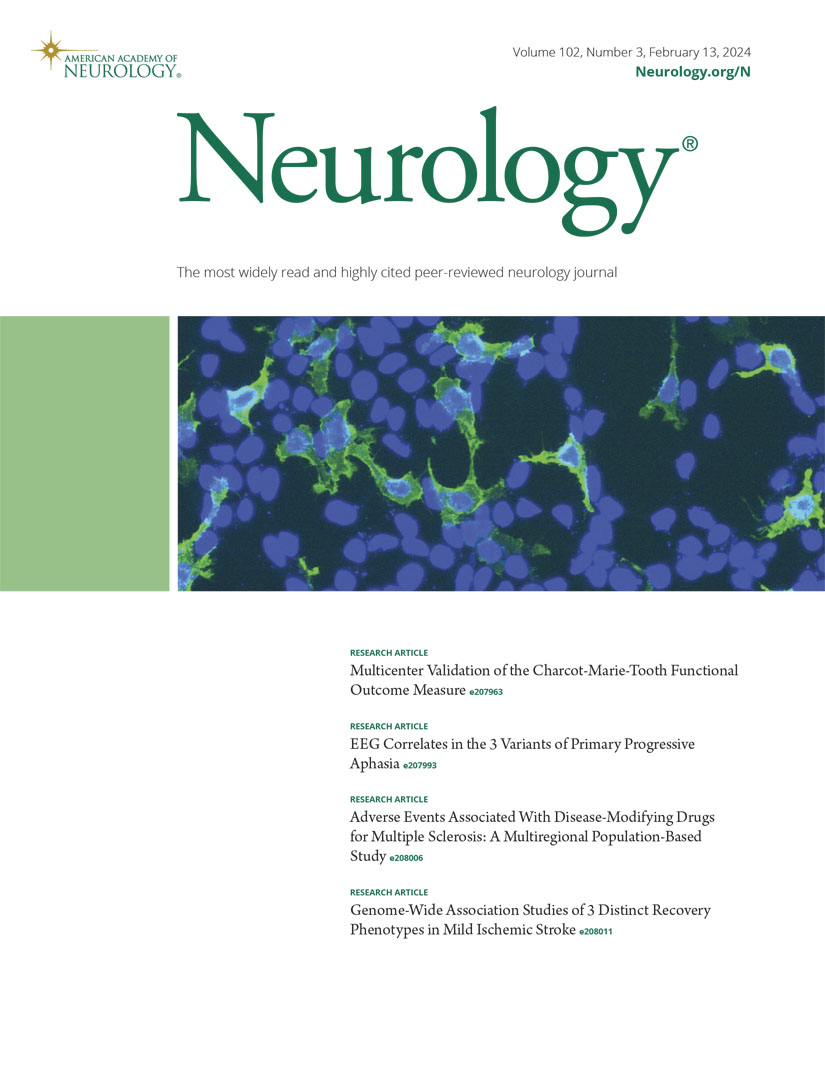阿尔茨海默病典型和非典型表型个体的生存差异
IF 7.7
1区 医学
Q1 CLINICAL NEUROLOGY
引用次数: 0
摘要
背景与目的阿尔茨海默病(AD)患者的生存估计有助于了解疾病发展轨迹,但对非典型AD变体的精确估计却很少。非典型AD变异的特点是非遗忘表型,发病早,APOEε4携带者的患病率较低,这影响了AD的发展轨迹。我们的目的是提供后皮质萎缩(PCA)、听力减少变异原发性进行性失语症(lvPPA)和行为性AD (bvAD)的生存估计,并评估这些非典型AD诊断的影响,而不是已知的死亡率决定因素。方法:从阿姆斯特丹痴呆队列中,我们回顾性地选择了生物标志物证实的散发性AD患者,这些患者在轻度认知障碍或痴呆阶段出现在记忆诊所。患者分为非典型AD表型(PCA、lvPPA、bvAD;多学科共识和回顾性病例发现)和典型AD参照组(不包括无法分类的非典型表现或未确诊的未来AD痴呆)。通过Kaplan-Meier分析确定了从第一次就诊到死亡/审查(中央公共管理)的生存估计,并比较了各诊断组的生存估计(对数秩检验)。为了评估非典型AD与死亡率的关系,我们构建了Cox比例风险模型,包括年龄、性别、教育程度、MMSE评分和APOEε4携带者(模型1),然后加入非典型AD组(模型2)或非典型AD变体(模型3)。采用似然比检验比较模型1和模型2的拟合性。结果共2081例AD患者(年龄65±8岁,女性52%)分为典型AD (n = 1801)和非典型AD (n = 280;PCA [n = 112], lvPPA [n = 86], bvAD [n = 82])。非典型AD患者的估计中位生存时间为6.3年(95% CI[5.8-6.9]),短于典型AD患者(7.2年[7.0-7.5],p = 0.02)。非典型AD变体的中位生存时间一致(尽管不显著)更短(PCA: 6.3 [5.5-7.3], p = 0.055;lvPPA: 6.6 [5.7-7.7], p = 0.110;bvAD: 6.3 [5.0-9.1], p = 0.121, 48%死亡)。纳入非典型AD改善了模型拟合(模型2;χ2 = 8.88, p = 0.003),与典型AD相比,死亡风险增加31%(危险比[HR] = 1.31 [1.10-1.56], p = 0.002)。在模型3中,各变异的贡献如下:HRPCA = 1.35 (1.05-1.73), p = 0.019;HRlvPPA = 1.27 (0.94-1.69), p = 0.114;HRbvAD = 1.31 (0.94-1.83), p = 0.105。非典型AD (PCA, lvPPA, bvAD)的生存期比典型AD短。这些非典型变异与年龄、性别、教育程度、APOEε4携带者和疾病严重程度以外的死亡率增加有关。未来的研究需要解决这些发现的普遍性,并确定解释观察到的生存差异的因素。本文章由计算机程序翻译,如有差异,请以英文原文为准。
Survival Differences Between Individuals With Typical and Atypical Phenotypes of Alzheimer Disease.
BACKGROUND AND OBJECTIVES
Survival estimates for individuals with Alzheimer disease (AD) are informative to understand the disease trajectory, but precise estimates for atypical AD variants are scarce. Atypical AD variants are characterized by nonamnestic phenotypes, an early onset, and lower prevalence of APOEε4 carriership, which affect the AD trajectory. We aimed to provide survival estimates for posterior cortical atrophy (PCA), logopenic variant primary progressive aphasia (lvPPA), and behavioral AD (bvAD) and to evaluate the effect of these atypical AD diagnoses beyond known mortality determinants.
METHODS
From the Amsterdam Dementia Cohort, we retrospectively selected patients with biomarker-confirmed sporadic AD presenting at the memory clinic in the mild cognitive impairment or dementia stage. Patients were classified into atypical AD phenotypes (PCA, lvPPA, bvAD; multidisciplinary consensus and retrospective case finding) and a typical AD reference group (excluding unclassifiable atypical presentations or unconfirmed future AD dementia). Survival estimates from the first visit to death/censoring (Central Public Administration) were determined (Kaplan-Meier analysis) and compared (log-rank tests) across diagnostic groups. To assess associations of atypical AD with mortality, Cox proportional hazard models were constructed including age, sex, education, MMSE score, and APOEε4 carriership (model 1), followed by adding the atypical AD group (model 2) or atypical AD variants (model 3). A likelihood ratio test was performed to compare the fit of model 1 and model 2.
RESULTS
A total of 2,081 patients (aged 65 ± 8 years, 52% female) were classified as typical AD (n = 1,801) or atypical AD (n = 280; PCA [n = 112], lvPPA [n = 86], and bvAD [n = 82]). The estimated median survival time for atypical AD of 6.3 years (95% CI [5.8-6.9]) was shorter than for typical AD (7.2 [7.0-7.5], p = 0.02). Median survival durations across the atypical AD variants were consistently, albeit nonsignificantly, shorter (PCA: 6.3 [5.5-7.3], p = 0.055; lvPPA: 6.6 [5.7-7.7], p = 0.110; bvAD: 6.3 [5.0-9.1], p = 0.121, 48% deceased). Including atypical AD improved the model fit (model 2; χ2 = 8.88, p = 0.003) and was associated with 31% increased mortality risk compared with typical AD (hazard ratio [HR] = 1.31 [1.10-1.56], p = 0.002). In model 3, contributions of the variants were as follows: HRPCA = 1.35 (1.05-1.73), p = 0.019; HRlvPPA = 1.27 (0.94-1.69), p = 0.114; HRbvAD = 1.31 (0.94-1.83), p = 0.105.
DISCUSSION
Survival in atypical AD (PCA, lvPPA, bvAD) was shorter compared with typical AD. These atypical variants are associated with increased mortality beyond age, sex, education, APOEε4 carriership, and disease severity. Future studies are required to address generalizability of these findings and to identify factors that explain the observed survival differences.
求助全文
通过发布文献求助,成功后即可免费获取论文全文。
去求助
来源期刊

Neurology
医学-临床神经学
CiteScore
12.20
自引率
4.00%
发文量
1973
审稿时长
2-3 weeks
期刊介绍:
Neurology, the official journal of the American Academy of Neurology, aspires to be the premier peer-reviewed journal for clinical neurology research. Its mission is to publish exceptional peer-reviewed original research articles, editorials, and reviews to improve patient care, education, clinical research, and professionalism in neurology.
As the leading clinical neurology journal worldwide, Neurology targets physicians specializing in nervous system diseases and conditions. It aims to advance the field by presenting new basic and clinical research that influences neurological practice. The journal is a leading source of cutting-edge, peer-reviewed information for the neurology community worldwide. Editorial content includes Research, Clinical/Scientific Notes, Views, Historical Neurology, NeuroImages, Humanities, Letters, and position papers from the American Academy of Neurology. The online version is considered the definitive version, encompassing all available content.
Neurology is indexed in prestigious databases such as MEDLINE/PubMed, Embase, Scopus, Biological Abstracts®, PsycINFO®, Current Contents®, Web of Science®, CrossRef, and Google Scholar.
 求助内容:
求助内容: 应助结果提醒方式:
应助结果提醒方式:


